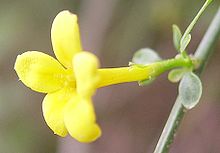Shrub jasmine
| Shrub jasmine | ||||||||||||
|---|---|---|---|---|---|---|---|---|---|---|---|---|

Shrub jasmine ( Jasminum fruticans ) |
||||||||||||
| Systematics | ||||||||||||
|
||||||||||||
| Scientific name | ||||||||||||
| Jasminum fruticans | ||||||||||||
| L. |
The shrub jasmine ( Jasminum fruticans ) is a shrub from the olive family (Oleaceae). Its distribution area is in Europe, western Asia and North Africa. The species is sometimes used as an ornamental plant because of its flowers. According to E. Banfi (2014), the species is better than Chrysojasminum fruticans (L.) Banfi in the genus Chrysojasminum .
description
The shrub jasmine is an evergreen or evergreen, upright shrub up to 1.25 meters high with rod-shaped, striped, green branches. The leaves are alternate. The leaf blade is threefold, the leaflets are 0.8 to 2 inches long, oblong spatulate and blunt. They are leathery, dark green and finely hairy. The flowers are in small groups of two to five on short side branches. They are 1.5 inches wide and yellow. The species blooms from July to September.
The number of chromosomes is 2n = 26.
Distribution and ecology
The distribution area of the shrub jasmine is in Europe in Moldova , on the Crimea (Ukraine), on the Balkan Peninsula, in Italy, France, Spain and Portugal; in Africa in Algeria, Morocco and Tunisia and in Asia in Iran, Israel, Jordan, Lebanon, Syria, Turkey and in the Caucasus (Armenia, Azerbaijan and Georgia). It grows in steppes and dry forests on moderately dry to fresh, acidic to neutral, sandy to sandy-humic, moderately nutrient-rich soils in sunny and hot locations. The species is sensitive to frost.
Systematics and research history
The shrub jasmine ( Jasminum fruticans ) is a species from the section Alternifolia , genus Jasminum , which is assigned to the tribe Jasmineae, family Oleaceae . The species was first described by Carl von Linné in his work Species Plantarum in 1753 .
use
The shrub jasmine is sometimes used as an ornamental plant because of its decorative flowers, including in Central Europe.
proof
literature
- Andreas Roloff , Andreas Bärtels: Flora of the woods. Purpose, properties and use. With a winter key from Bernd Schulz. 3rd, corrected edition. Eugen Ulmer, Stuttgart (Hohenheim) 2008, ISBN 978-3-8001-5614-6 , p. 355.
- Schütt, Schuck, Stimm: Lexicon of tree and shrub species . Nikol, Hamburg 2002, ISBN 3-933203-53-8 , pp. 233 .
Individual evidence
- ↑ German name after Roloff et al .: Flora of the woods and Schütt, Schuck, Stimm: Lexikon der Baum- und Straucharten .
- ↑ Rafaël Govaerts (Ed.): Chrysojasminum fruticans. In: World Checklist of Selected Plant Families (WCSP) - The Board of Trustees of the Royal Botanic Gardens, Kew . Retrieved December 8, 2017.
- ↑ a b c Roloff et al .: Flora of the Woods , p. 355
- ↑ Jasminum fruticans at Tropicos.org. In: IPCN Chromosome Reports . Missouri Botanical Garden, St. Louis
- ↑ a b Jasminum fruticans. In: Germplasm Resources Information Network (GRIN). United States Department of Agriculture, accessed February 5, 2012 .
- ↑ Schütt et al .: Lexicon of Tree and Shrub Species , p. 233

